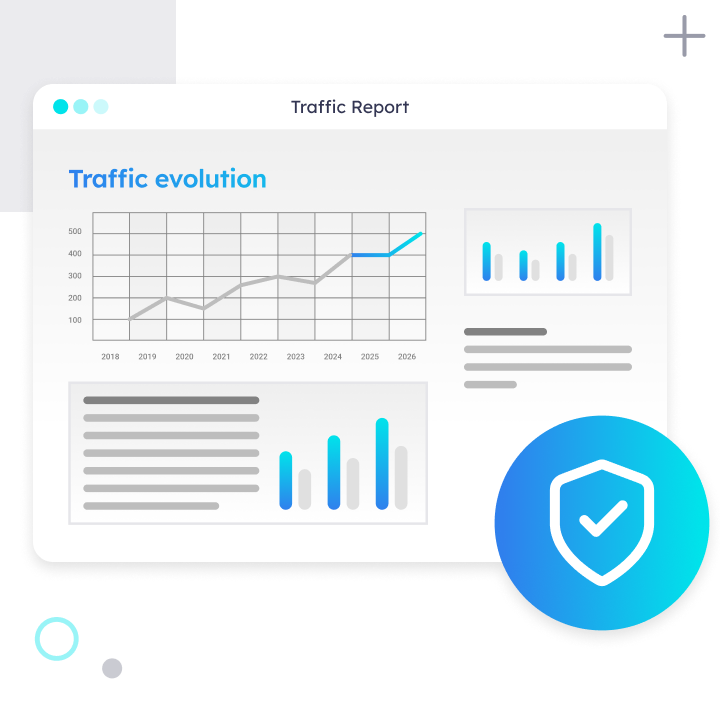CRO used to be a craft of tweaks and patience. Change a headline, shift a button color, wait weeks for the data to roll in. If you were disciplined, you could squeeze out a few percentage points of improvement and call it a win. That era is over.
In 2025, conversion rate optimization has become a high-speed, AI-driven discipline—closer to autonomous trading than slow-burn experimentation. Customer expectations are instant. Acquisition costs are rising relentlessly. And the competitive edge no longer comes from isolated wins, but from systems that optimize continuously, across every touchpoint, without waiting for permission.
We’re entering a phase where smart A/B testing is just the entry ticket. The real performance leaps will come from agentic AI: autonomous systems that generate hypotheses, run experiments, and deploy winning changes in real time. Coupled with predictive analytics, intent-based microexperiences, and a privacy-first approach to personalization, these innovations are reshaping what CRO means, and raising the bar for what it takes to win.
This is the CRO playbook for the next era: how to evolve from running tests to running an always-on optimization engine that compounds results week after week.
Table of Contents
Why is time to ditch traditional CRO?
The CRO playbook that worked five years ago is now a liability. Static A/B tests, monthly reviews, and minor UX tweaks can’t keep pace with markets that shift in hours, not quarters. In today’s environment, by the time you’ve gathered “statistical significance,” your winning variation may already be losing.
User expectations have outgrown the old models. They no longer tolerate generic landing pages or linear funnels. They expect instant relevance, frictionless navigation, and experiences that feel tailored to their intent in the moment—not just to their demographic profile. The rise of multi-device browsing, voice and visual search, and hyper-contextual offers means every click is a moving target.
At the same time, the privacy-first internet is changing how we collect and use data. The decline of third-party cookies forces brands to lean on first-party and zero-party data, but collecting it is only half the battle, making it actionable in real time is the new frontier. If your CRO process isn’t engineered to adapt to these shifts automatically, you’re playing defense while competitors’ AI is already scoring points.
Traditional CRO gave us the foundation. But in 2025, the winners are those who combine data, design psychology, and autonomous AI into a system that never stops learning, never stops adapting, and never needs to wait for the next test cycle to act.
So, what are the hottest, most-effective CRO trends?
1. Agentic AI for smarter personalization
The CRO leaders of 2025 aren’t just using AI, they’re handing the steering wheel to it. Agentic AI goes beyond pre-set personalization rules or campaign automations. These systems act autonomously within defined parameters, continuously learning from user behavior, context, and environmental signals. The result is a living, adaptive website experience that evolves with each visitor, often in ways a human marketer wouldn’t anticipate.
The advantage is twofold: speed and precision. Agentic AI doesn’t just respond to “if/then” scenarios; it predicts shifts in intent and adjusts messaging, layout, and offers before a user’s attention slips away. That’s why it’s becoming the go-to tool for brands with complex, high-value funnels where every interaction counts.
Spotify, for instance, doesn’t simply recommend playlists based on your past listening habits. Its Agentic systems account for time of day, device type, recent skips, and even regional trends , meaning two users searching for “jazz” at 9 AM on a Monday may see entirely different playlists, both optimally relevant.
Best practices:
- Integrate your Agentic AI with your CRM, analytics platform, and on-site personalization tools so it operates on the richest possible dataset.
- Focus on modular content blocks (headlines, hero images, CTAs) that AI can rearrange or rewrite in real time.
- Establish clear brand guardrails to ensure that autonomous adjustments always align with your tone, visual identity, and compliance requirements.
2. Predictive journey orchestration
In CRO, reacting to user behavior is already table stakes. The competitive edge now lies in anticipating what a visitor will do next, and shaping that future in your favor. Predictive journey orchestration uses behavior modeling to map out likely next steps and then dynamically places the right nudge, asset, or offer at exactly the right moment.
Think of it as playing chess, not checkers. Instead of responding to a single move, you’re thinking several steps ahead, setting up a series of actions that subtly guide the user toward conversion without them ever feeling “pushed.” This is particularly valuable in high-consideration funnels where drop-off points are well-known but historically hard to preempt.
That’s exactly how Klarna identifies cart abandonment risk, not by the absence of clicks, but by micro-signals: prolonged scrolling without action, hesitating over the “Pay in 3” option, or returning to a product page multiple times in one session. When these signals align, it triggers an offer — a payment plan reminder, a free shipping prompt — right before the user mentally exits.
Best practices:
- Audit your funnel to identify micro-signals that precede both conversions and drop-offs.
- Pair machine learning models with session recordings to validate predictive assumptions.
- Test different intervention types (soft reassurance vs. incentive) to see which resonates with different intent tiers.
Free template: CRO audit checklist
Discover everything you need to start identifying drop-offs and increase conversions.

3. Zero-data A/B testing
The traditional A/B testing model — set it up, wait for a huge traffic sample, then declare a winner — is buckling under the demands of modern CRO. In a world where many brands don’t have the luxury of massive traffic volumes, zero-data A/B testing flips the process on its head. Using machine learning, these systems adjust the distribution of traffic in real time, learning which variant performs best without needing weeks or thousands of visits to reach statistical significance.
For niche markets or high-ticket products, this is a game changer. Instead of shelving potentially strong ideas because “we don’t have enough data,” marketers can validate creative, UX, or messaging changes quickly and with confidence. Even for larger brands, the ability to iterate on winning concepts in days instead of months compounds CRO gains over time.
Best practices:
- Adopt platforms that support adaptive experimentation rather than fixed traffic splits.
- Use a blend of quantitative data (click-through, conversion rate) and qualitative feedback (user polls, live chat transcripts) to interpret results.
- Start with high-impact elements — headlines, CTAs, hero images — before moving to deeper funnel refinements.
4. Real-time content morphing
Static websites are quickly becoming relics. In 2025, the CRO frontier is about continuous adaptation: the ability for a site to reshape itself based on live user signals, environmental context, and external data sources. This is more than swapping banners for a sale; it’s a system that adjusts everything from copy tone to feature prioritization the moment new intent signals appear.
The shift is psychological as well as technical. Users now expect the same responsiveness from a website that they get from a human conversation: relevant, fast, and situationally aware. The reward for meeting that expectation is deeper engagement and faster decision-making.
That’s why, on a rainy day in London, a mobile user of a travel agency might see “Last-Minute Sun Escapes” with a one-tap booking link, while a desktop visitor in New York browsing in the evening could see “Plan Your Winter Ski Retreat.”
Best practices:
- Integrate third-party APIs (weather, location, market trends) into your personalization stack.
- Use behavioral segmentation to determine why a user is visiting before deciding what to show them.
- Test transitions to ensure content morphing feels seamless rather than jarring.
5. First-party data-driven CRO
The cookieless future is no longer “coming”, it’s here. That means the brands winning at CRO are those building robust first-party data strategies. Instead of relying on third-party tracking, they’re collecting data through value-driven exchanges: interactive tools, loyalty programs, gated content, and personalized onboarding.
The goal isn’t just to gather data, but to activate it in ways that enhance the customer journey while respecting privacy. Brands that master this are able to keep personalization sharp, even as privacy regulations tighten and browsers block traditional tracking methods.
Best practices:
- Use progressive profiling to collect small pieces of data over multiple interactions.
- Provide clear value in exchange for data, whether through exclusive offers, tailored recommendations, or premium resources.
- Be transparent about how data is stored and used to build trust.
6. Predictive checkout optimization
A friction-heavy checkout is still the single largest conversion killer in e-commerce, but the next generation of CRO isn’t just about streamlining steps, it’s about predicting where and why a user is likely to stall, and solving the problem before it happens.
Predictive checkout optimization blends behavioral analytics with historical purchase data to foresee abandonment triggers: a pause at the shipping options screen, switching tabs after viewing the total price, or selecting a payment method and then removing it. The intervention can be as simple as highlighting “Free Returns” or offering an alternative payment option at the exact moment of hesitation.
Best practices:
- Map common hesitation points in your checkout flow using session recordings and analytics.
- Deploy micro-interventions (security badges, trust signals, shipping calculators) targeted at specific friction moments.
- Test mobile-first checkout improvements — often the biggest source of quick wins.
7. Cross-device conversion continuity
By 2025, customers are weaving in and out of devices like it’s second nature. They might research on their work laptop between tasks, check competitor pricing on their phone while queuing for coffee, and finally click “buy” on a tablet curled up on the sofa. The problem? Too many CRO strategies still treat these as isolated, unrelated visits, effectively wiping the slate clean every time a user switches screens. That’s a surefire way to lose context and, inevitably, conversions.
True cross-device continuity means more than adding a “save for later” button. It’s about creating a living, breathing shopping journey that follows the customer wherever they go. Imagine a cart that syncs instantly, even when someone adds an item on mobile and completes checkout on desktop hours later. Or a search history that pops back up exactly as they left it, alongside recommendations that still make sense in the context of their earlier browsing. When you remove friction like this, the experience stops feeling transactional and starts feeling like an ongoing conversation.
Best practices:
- Implement cloud-based session storage to unify interactions across devices.
- Use identity resolution to connect anonymous browsing with known profiles where privacy allows.
- Design flows that anticipate and support mid-journey device switches.
8. Voice and visual search–ready CRO
Voice assistants, AR shopping tools, and image recognition aren’t on the horizon anymore — they’re in people’s homes, in their hands, and influencing how they shop right now. For CRO, that means understanding that a purchase journey might begin with “Find me vegan running shoes size 8” spoken into a phone, or with a customer snapping a picture of a chair in a café to find a similar one online.
A furniture retailer, for example, doesn’t just upload pretty product photos. They invest in rich metadata so that Google Lens can match their products to in-the-wild images. Meanwhile, their mobile app is designed for conversational queries, allowing customers to say, “Show me armchairs under $300 in navy blue”, and get instant, filtered results. These experiences collapse the gap between desire and decision, cutting out countless clicks.
Best practices:
- Integrate conversational, long-tail keywords into your content for voice queries.
- Add schema markup to support voice assistant responses.
- Use optimized alt text and “visual similarity” tags for all product images.
- Experiment with AR or VR try-ons to shrink the decision-making window.
9. Emotion-led conversion design
For years, CRO has obsessed over clarity, speed, and ease, but now emotional resonance is stepping into the spotlight. Neurodesign principles are showing us that the way a button animates, the warmth of a color palette, or the pacing of a page transition can nudge a visitor toward “yes” more effectively than another bullet list of product benefits.
Think about a travel site that shifts tone throughout the user’s journey. In the exploration phase, the site might greet visitors with sweeping drone footage of serene beaches and soft, unhurried animations that invite dreaming. But as the customer approaches the booking stage, the design subtly ramps up urgency — brighter calls-to-action, limited-offer badges, and snappier interactions to signal that now is the time to act. These changes aren’t manipulative; they align with the emotional arc the user is already experiencing.
Translate all your data into clear insights
Discover how to future-proof your marketing data strategy with AI-powered analytics.

Best practices:
- Research your audience’s emotional motivators through interviews or heatmaps.
- Apply psychology-informed design patterns such as the Peak-End Rule to leave a lasting impression.
- Use micro-interactions and motion cues to reinforce positive decisions.
10. CRO for the eco-conscious buyer
Sustainability has shifted from background noise to a buying trigger. Today’s eco-aware shoppers don’t just appreciate green credentials, they actively seek them out, and they’re willing to pay more for products that match their values. Yet many websites bury sustainability content in a blog post or a corporate responsibility page that customers will never see.
Best practices:
- Display environmental impact data where buying decisions happen.
- Include sustainability cues in remarketing and abandoned cart messages.
- Offer eco-friendly shipping or packaging as a low-friction, visible choice.
How Pathmonk future-proofs your CRO strategy
Pathmonk helps you stay ahead of the CRO curve by combining real-time behavioral intelligence, agentic AI personalization, and privacy-first data strategies into a single, scalable platform. Instead of relying solely on static A/B tests or generic optimization rules, Pathmonk continuously adapts your website experience based on a visitor’s intent, stage in the journey, and contextual signals.
We don’t just help you see what visitors are doing, we help you predict what they’re about to do and trigger the right micro-experience at exactly the right moment. From on-page content adjustments to dynamic lead capture flows, every interaction is fine-tuned to move the visitor one step closer to conversion.
Pathmonk’s cookieless technology ensures you can personalize at scale without breaching privacy regulations, while our first-party data integrations make sure your insights and optimizations are future-proof against platform changes. Whether it’s simplifying the checkout experience, tailoring product recommendations, or surfacing the right message for eco-conscious buyers, Pathmonk gives you the agility and intelligence to optimize for today while preparing for what’s next.
Ready to see it in action? Try our free interactive demo or talk to one of our experts for a personalized tour!





